Did you find this article helpful for what you want to achieve, learn, or to expand your possibilities? Share your feelings with our editorial team.


Nov 15, 2022
TECH & DESIGNSystematizing UX design : future mobility products and services based on end-user perspectives
Denso's UX Principle, and the UX evaluation system based on it
-
UX Innovation Center Dept.Jinhae Choi Ph.D.
Jinhae Choi worked for an overseas manufacturing company in the company-wide UX management and the UX development of home appliances, IT and services before joining DENSO in 2018. In 2014, he won a Grand Prix award in the “Interaction and User Experience” category in the Red Dot Design Award competition—one of the world’s top three design competitions—and in 2015 served on the UX-field committee for the ACM CHI.* Currently, Choi promotes planning activities based on customer experiences, and develops UX collaborations with OEM customers.
※The Conference on Human Factors in Computing Systems (CHI) hosted by the Association for Computing Machinery (ACM). -
UX Innovation Center Dept.Asaki Umezawa
Asaki Umezawa was involved in User Interface designing in an office equipment manufacturer. After that he was an UX designer and a project manager in an IT company and a car manufacturer.He won the Good Design Award from 2012 to 2014, and worked for Musashino Art University as a part-time lecturer from 2017 to 2018. He joined DENSO in 2021, and currently heads up efforts to create the UX governance framework for DENSO.
Since 2018, DENSO Corporation has been pursuing innovations in vehicle development processes with a focus on the user experience, or “UX.” We talked with DENSO’s Jinhae Choi and Asaki Umezawa about what UX-based development entails, as well as their establishment of the “UX Principle” and use of big-data analysis for daily lifestyle factors.
Contents of this article
Creating the “UX principle” guidelines for mobility development
Products in a wide range of different industries today compete with each other for their UX. Dr. Choi, in the interview for our previous installment [link below], we talked about the UX Innovation Center which you established in 2018. Could you tell us more about it first?
Choi:Digital transformation (DX) is a major focus these days in the mobility industry. In other industries, a lot of attention is being given to services that achieve UX innovation. Such services have been leveraging the strengths of software to utilize digitalized user data for more than a decade, and this has had impacts on all industries. This includes the mobility industry, where we must now meet even higher user expectations.
But it’s not possible to solve everything by simply connecting cars with outside services. That’s because the user experience is a composite result of users’ cultural backgrounds, sense of values, patterns of behavior, and other elements such as user proficiency. A vehicle-related UX must incorporate “movement” as an additional variable, while also taking account of the actual experience when the services are used. We have established the UX Innovation Center during an era in which end-user-oriented approaches—in other words, planning activities and development based on UX—are becoming essential for DENSO, too.
Auto manufacturers are in a similar situation. They place a high priority on UX from the vehicle planning phase, and Western auto manufacturers expect suppliers to submit information on UX direction which includes principles and user research from the RFI (Request For Information) phase.
What do you think DENSO’s strong fields are, and what fields do you think it needs to improve?
Choi:I think DENSO’s strengths are its outstanding technological and development capabilities, as well as good organizational strengths which enable it to build powerful supply chains. Moreover, DENSO is very good at rapidly responding to any changes in the industry and moves of auto manufacturers.
On the other hand, no matter how good we are at taking decided action without fail, we have to improve the power to pioneer new fields where we have no experience. I think society will keep demanding even greater levels of safety and reliability, but if we limit ourselves to improving safety performance alone, our products will be nothing more than commodities. Therefore, in addition to improving the safety of automotive components, we must rethink which values our company needs to provide. For example, how can we ensure that people continue to enjoy their mobility lifestyles even when they purchase a new vehicle to replace their current one? By thinking about such things, we can offer UX that is optimized for each user.
That is why we’re creating a framework that will make sure that our users stay with the experience-based constructions provided by DENSO, and thus it leads to their continuous purchase of our products and services. My team and I are tasked with establishing the DENSO’s unique strategy of high value-added differentiation by planning the mobility as long-term total experiences.
I understand the UX Innovation Center works in collaboration with the Mobility Electronics Business Group. Does this entail production operations with UX factored in from the planning stage?
Choi:Yes. The Center started out as part of the Cockpit System Business Unit, and although the vehicle cockpit is a place where drivers and passengers connect with the vehicle, a true UX is, as I described earlier, formed and influenced by a variety of interwoven factors and accrues value based on users’ perceived experiences. In addition to the product itself, UX considerations must also include software, cloud-based services, third-party services, and other factors, which is why the UX Innovation Center now functions as a cross-functional organization together with the entire Mobility Electronics Business Group.
This year, we created and enacted the UX Master Plan for mid-to-long-term UX-based development. By using a Business Group-wide webinar format for all members, we aim to cultivate a greater focus on improvements and connections of the user experience from the planning stage, as well as the ability to implement this approach in the development and mass production stages while taking the customer’s viewpoint into consideration.
What specific activities are currently being carried out by the UX Innovation Center?
Umezawa:We are working on two types of activity: UX-based planning and development to create the future of DENSO, and UX development in tandem with co-creation together with OEMs. I’d like to explain the former this time.
We felt that it was necessary to create the “UX Principle” to ensure that developers involved with various products adopt the same UX-based planning and development approaches. Within the UX Principle, we have defined several guidelines on required experiential factors for the mobility field, and based on these guidelines we are working with developers to create a UX strategy, foster directionality, and develop solutions related to UX.
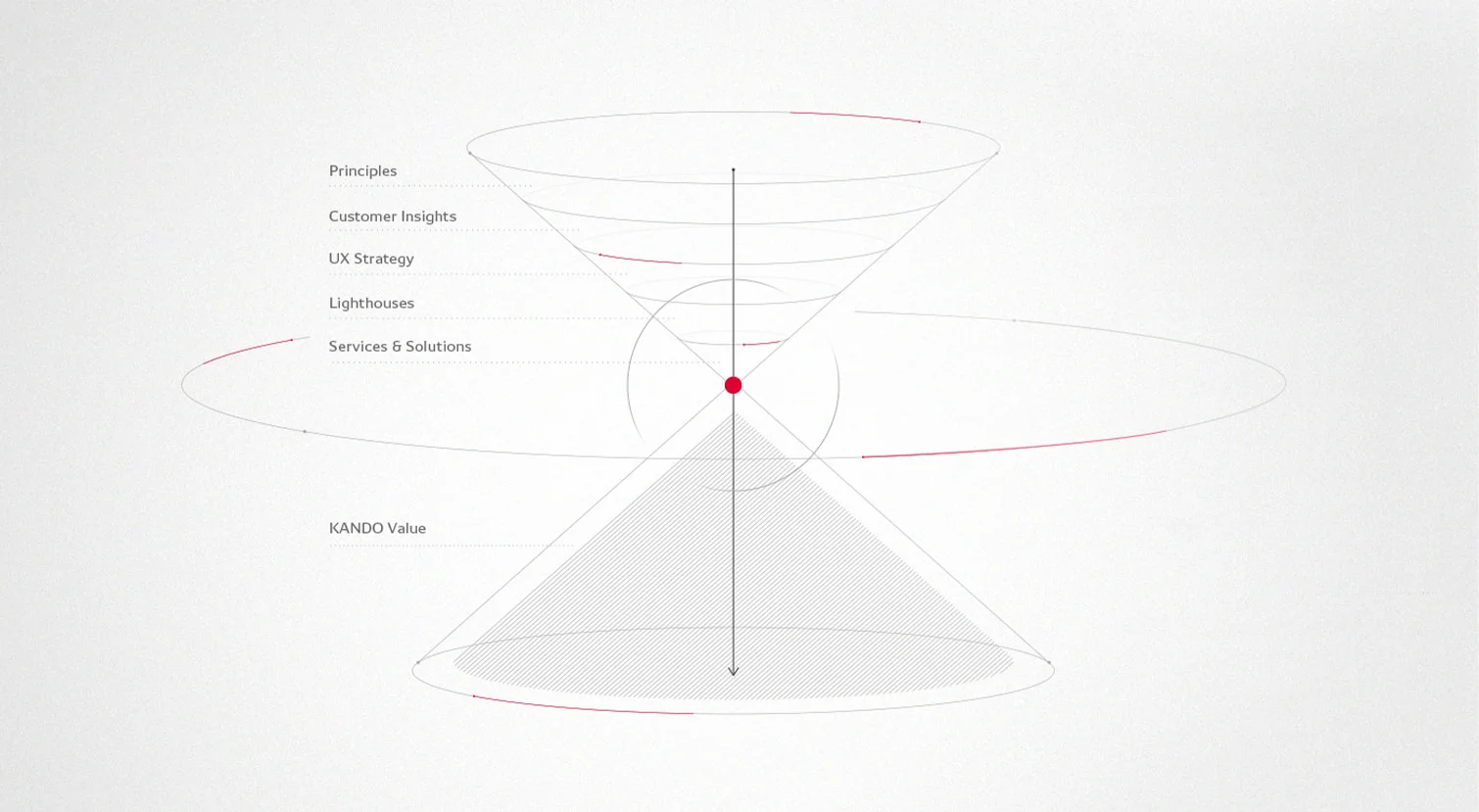
Umezawa:The UX Principle comprises six guidelines: “Perceptibility,” which means obtaining correct information to help decision-making; “Intuitive Information,” meaning never interfering with natural behaviors; “Contextual Experience,” the provision of experiences based on understanding and nuances; “Personalization,” meaning to develop experiences optimized to individual user states and conditions; “Peace of Mind,” to build trust so that users can rely on us; and “Green,” which means helping to enrich people’s lives. To achieve UX based on these guidelines, we set numerical values for factors such as text and icon sizes, response times, and display durations for various results, and then use these values as UX indicators.
Take an in-car display device, for example: when we attempt to create numerical indicators for determining an easy-to-read text size, we must take into consideration the driver, visual range relative to the device, and other such variables. When working with instruments clusters, center display screens and HUD, we have to use different indicators for each device and system. This numerical analysis and representation of the UX cannot be carried out on a function-by-function basis; ultimately, it must consider the situation in which the UX occurs, the user’s personal values, and other related factors. Although function-by-function quality improvements are important, it’s also necessary to numerically assess user value when functions are actually used.
Therefore, through continuing research we are also trying to gain a better understanding of how users perceive and feel about their experiences by factoring in visual range, individual devices, screen resolutions and other such elements. To create definitions for legible display sizes during driving and when stopped, for example, we show different sample text sizes to users and, based on the results, calculate the recommended size and minimum size values. Using the results of such experiments, we are developing a program that can automatically calculate recommended text size based on visual range, screen resolution and other relevant factors, and then establish the resulting values as in-house guidelines at DENSO.
Information on the UX Principle and guidelines is available online on the D-EXPERIENCE DESIGN SYSTEM website.
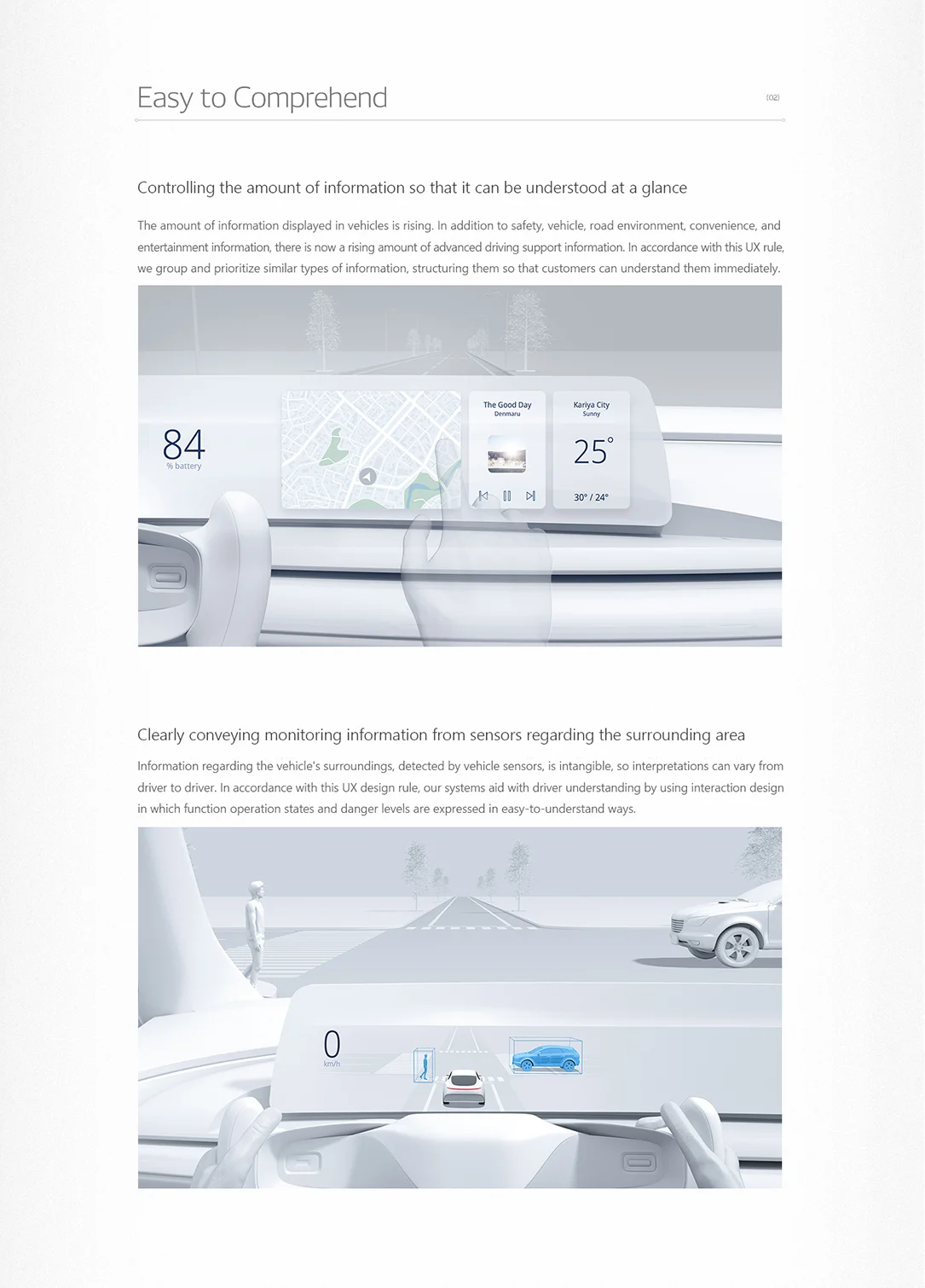
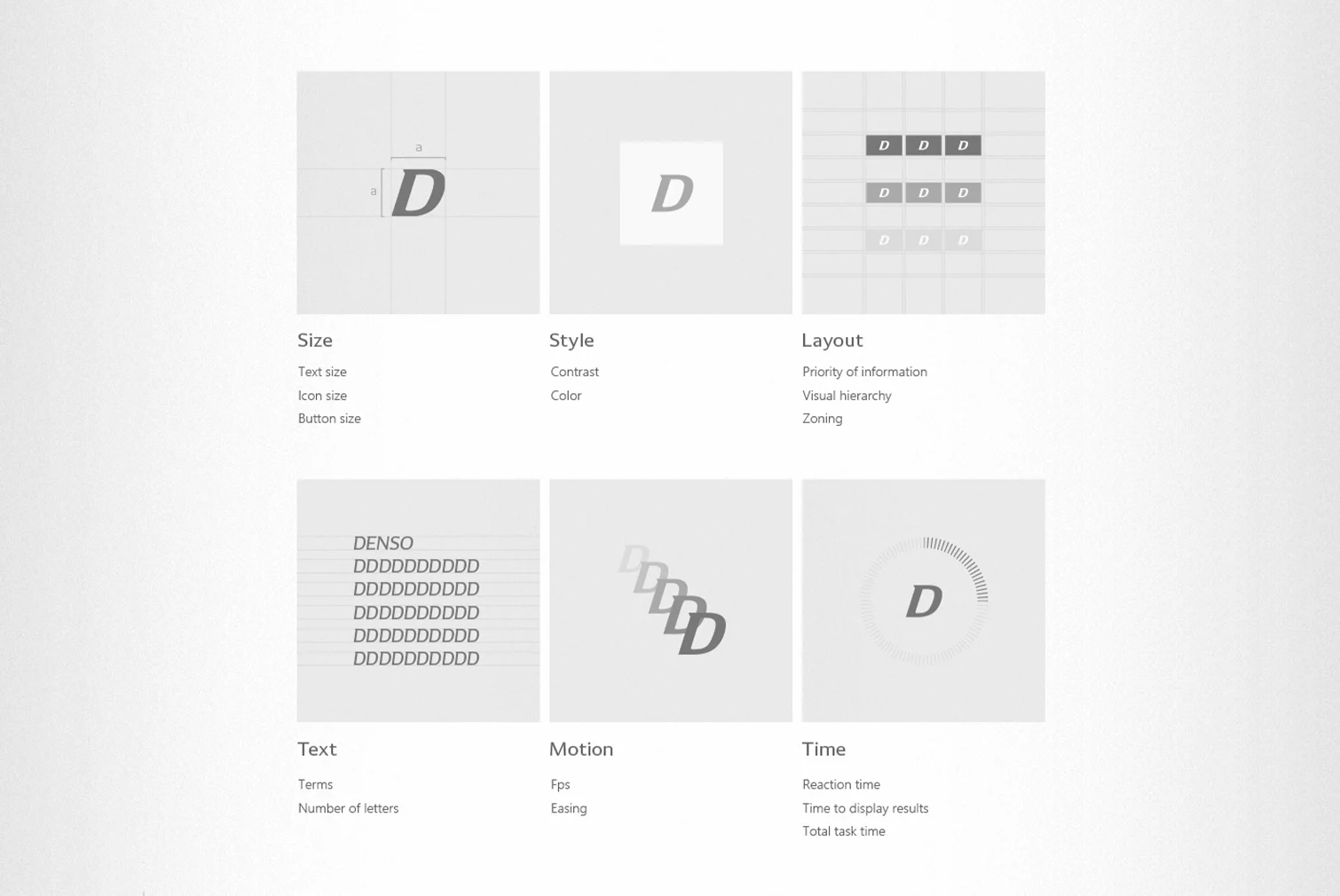
Using big-data analyses of daily lifestyle factors in development operations
What does the creation of numerical indicators for “how users feel” actually involve?
Umezawa:With a vehicle UX, it’s necessary to have a good overall grasp of all relevant factors such as travel speed, surrounding scenery and traffic conditions. The developer must personally understand and implement design based on an understanding of how the user responds and feels regarding these factors, as well as the reasons for those feelings. It’s also important to incorporate ad hoc VoE (voice of employee) and VoC (voice of customer) feedback into the design. To achieve these things, we are developing a smartphone app for gathering UX data. This app enables developers to efficiently reflect UX factors in development operations, and also enables quantitative understanding of UX by the Business Group as a whole.
Who will use your UX data collection app?
Umezawa:In the future, we hope that all users in general will use the app, but first we are targeting in-house development personnel at DENSO. Developers use the app to photograph a product they are developing, or a product being developed in another part of DENSO, and then select a general category such as “instruments,” “HUD” or “center information display.” Next, they evaluate the product in a simple fashion on a numerical scale, based on the six guidelines of the UX Principle.
We are able to assess the results based on gender, age and other such categories. This may tell us, for example, which colors are most legible for women in their twenties, or what kinds of experiences men in their fifties find to be a nuisance, and thus grasp fundamental information on factors behind the UX.
DENSO is often faced with the question of how to solve UX-related problems related to automobiles that are faced by society as a whole. By collecting a wide range of information via the app, we hope to identify issues faced within DENSO, figure out which UX-related problems DENSO can solve, and also pursue discussions and solutions in a data-driven manner.
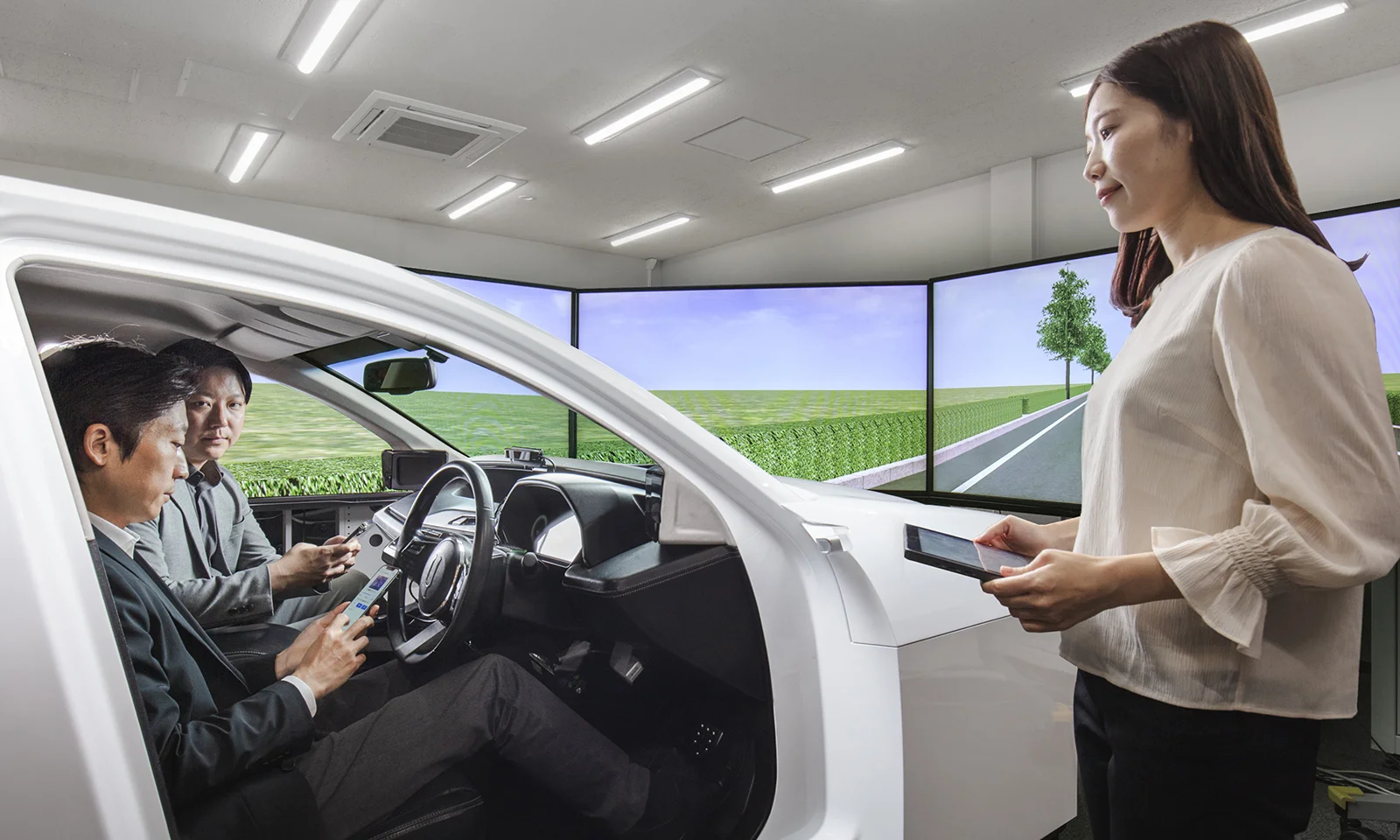
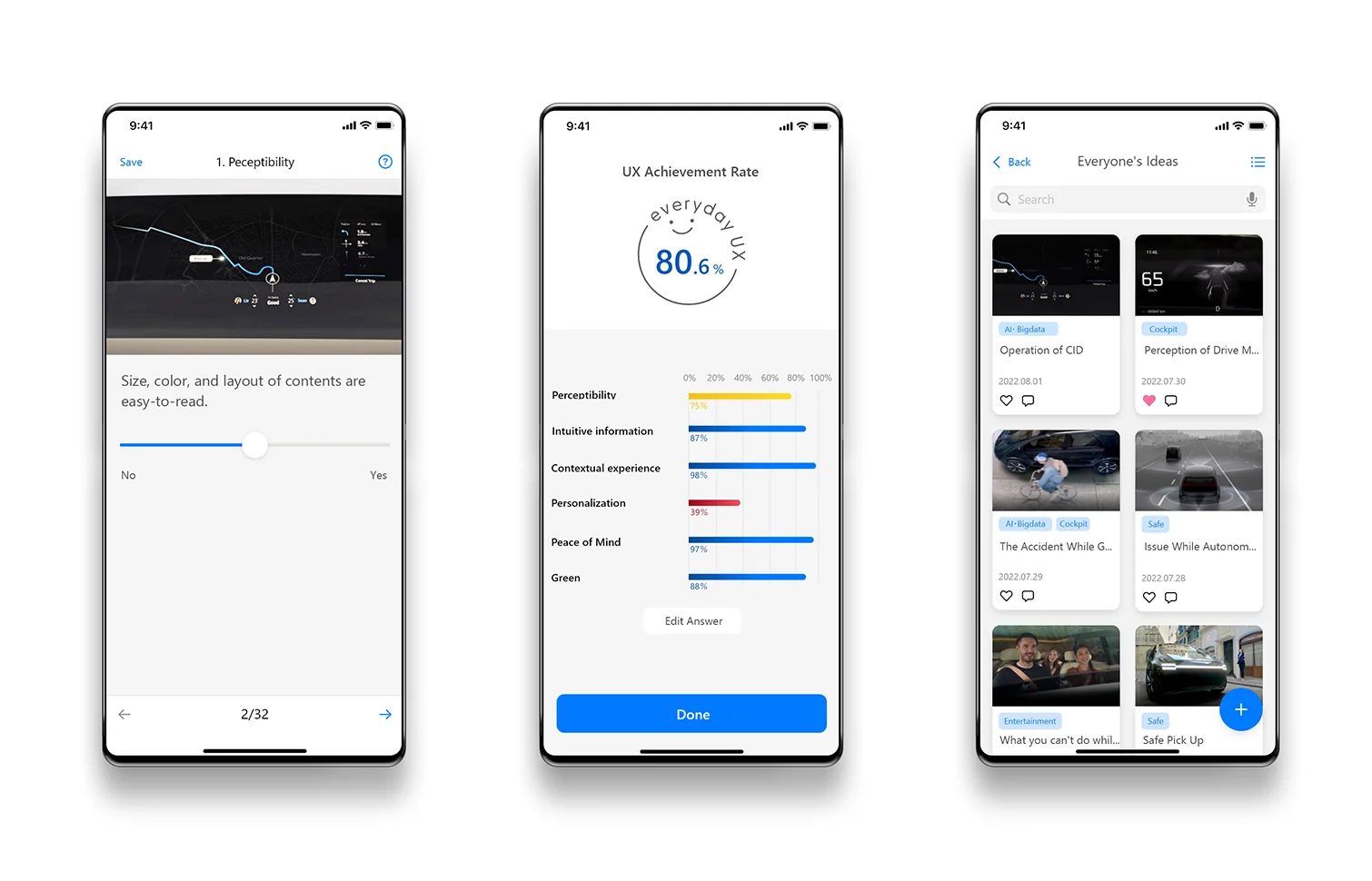
As you describe it, the app in its current form is used to photograph and then evaluate products. In the future, will it be able to collect information on user sensations as well?
Umezawa:With DENSO technologies, it’s possible to monitor information like user facial expression and heart rate. However, we are still discussing the best ways to implement such app usages from a UX standpoint. Right now, this beta-stage app uses questionnaires which are answered by users, but the next step will probably be to collect data on users’ biological signals and use it for UX development.
Choi:User evaluation results are helpful, but if we are able to also understand their biological reactions as they are making evaluations, it would increase analytical precision. One possibility would be to use a smartwatch to measure heart rate, perspiration and other such biological reactions during evaluations. However, filtering out noise when attempting to do this in dynamic situations is challenging, so we’re starting our research with static situations. In this research, we’re using functional magnetic resonance imaging (fMRI) to monitor reactions in the user’s brain when they look at a car’s interior design, and can thus determine when they feel an interior is safe and comfortable, luxurious, or perhaps cutting-edge. Breaking something down like this is the opposite of the assembly process in design work, so by converting non-digital, biological information from human users into digital data, we can effectively reflect results in UX design.
You mentioned analyzing UX results as big-data sets. How are you doing this?
Umezawa:We’re using DENSO’s know-how to create the framework. Thus far, the UX Innovation Center has worked with outside companies on diverse research targeting around 1,000 to 2,000 users at a time, but the problem with that approach is that we don’t have the experience and knowledge necessary to analyze such data ourselves.
Collecting UX data through the app not only enables us to carry out UX evaluation, but also allows us to administer questionnaires to thousands of users and gather new ideas. Our goal is to bring together and combine all UX-related data and use it in product development.
To this end, the UX Innovation Center and other sections of DENSO are hiring and training personnel with the necessary data analysis skills while also using the app.
A future characterized by systematized UX designは
How do you intend to utilize UX data collected through the app for product development?
Choi:Our main priorities in developing the human–machine interface (HMI) so far have been to determine suitable processes and increase efficiency in order to fully utilize functions. Engineers in charge of HMI design have relied primarily on human-factor engineering knowledge, but in the future, we must also consider pure, unfiltered information on users in order to meet individual vehicle-related demands and achieve sustained progress and growth. Our app won’t solve everything, but it is the first step to gather UX evaluation information directly from users and tell us which UXs are popular and which are not. By using this information, we can develop a better UX. Currently, we are at the stage of pre-development and mass-production development.
Umezawa:When using such measurement tools, developers tend to measure success based on achieving numerical targets. However, I hope that developers throughout DENSO will focus instead on using the app to determine how end users actually feel about the products and systems we supply to them.
Currently, several in-house developers are using the app, and we have identified a number of issues to include the app into our product developments. By tackling these issues one by one, we will come closer to achieving true UX-based product developments.
How do you think UX design methodology will change in the future?
Umezawa:I think we will establish reliable data, knowledge and experience that tell us how users feel when things are presented to them in a certain way, and then use that to develop new products. In past product developments, designers usually tried out various ideas until they came up with a design, which then served as the basis for development. With UX design over the past decade or so, we’ve taken a trial-and-error approach for each product, starting from scratch every time, but this is beginning to change.
Take Web services and app design, for example: designers no longer design icons from scratch, as they can utilize existing icon assets, as well as button assets and so forth, in development. I think UX design will evolve in a similar fashion as we convert the knowledge and experience of leading UX designers into concrete, and engineers can use asset-type formats to develop other products.
Choi:Recent product design software is able to automatically generate design proposals by making use of past learning and engineering parameters. Integration of this type of generative design into operations has begun to transform the role of the designer. But what hasn’t changed is the fact that users who purchase a product will continue to use the design provided to them until it’s time to buy a replacement. On the other hand, with UX design—particularly the screen display units—designers must continue working on the product to facilitate continual over-the-air (OTA) updates, which are wireless updates to software. These updates include everything in the post-purchase changes from the graphical user interface (GUI) to the new-function integration through OS version updates. Therefore, UX designers must be able to do more than use GUI and UI tool skills; they must also track and research post-purchase usage conditions by product users and develop approaches that enable further improvements.
In other words, experiences are key in setting DENSO apart from the competition in the mobility field?
Choi:What will set us apart is the provision of unique and comprehensive experiences based on a fusion of our top-level technologies for safety and peace of mind and a good understanding of potential experience-based value for users. I believe this will lead to innovation which puts us ahead of the competition. At the UX Innovation Center, we carry out periodic global-scale surveys of latent user needs, and in recent years we’ve observed much higher user expectations in the mobility field in response to technologies such as electric vehicles (EVs) and automated driving. We hope to carry out research to better understand customers, and to create UX design systems that enable development based on those activities.
Umezawa:Once we analyze big data in regard to mobility-field UX information and knowledge, we believe there will be a growing demand for that knowledge in non-mobility fields as well. We hope to use our current UX-related endeavors to develop new business models for DENSO in the future.
If you are successful, will human designers become superfluous?
Umezawa:That won’t happen, but their roles will become more diverse. I was in charge of UI design at an office equipment manufacturer, UX research at a web design company and UX/UI design at an automotive manufacturer. Through these various jobs, I have seen firsthand just how diverse the roles of designers are becoming, and also how much the specialized knowledge of designers is growing in response.
Some designers are more experienced with tackling the “how” of an issue—in what way a product or system should be made—while others are better at answering the “why” of design. Some designers focus on the “what,” meaning they start from scratch and think about what to actually make. A new era is coming in which not only the “how” of design is systematized, but also the “why” and “what” are systematized, which is why we must think about the skills that designers will need in the future.
Choi:During the Renaissance period, Leonardo da Vinci was simultaneously a philosopher, an inventor, a scientist, a medical doctor, and even a sculptor. It is said they he worked in a dozen or more different capacities. Today, the equivalent to someone like him is a UX worker who develops “total experiences.” However, contemporary higher education divides fields into narrow, specialized categories, and people rarely stray outside of their personal area of expertise. Human designers will help us overcome this problem, and will thus remain crucial in the future.
Umezawa:In that regard, increasingly diversified designers will not only need to refine their specific areas of specialization, but also develop overarching, general skills. Human understanding is absolutely vital for research and development in the UX field, so we need designers whose skills are not limited to design alone, but also encompass areas such as cognitive psychology and behavioral economics, which can be used in development efforts.
COMMENT
Changing your "Can'ts" into "Cans"
Where Knowledge and People Gather.

